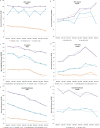The evolution of the epidemiological landscape of head and neck cancer in Italy: Is there evidence for an increase in the incidence of potentially HPV-related carcinomas?
- PMID: 29415020
- PMCID: PMC5802923
- DOI: 10.1371/journal.pone.0192621
The evolution of the epidemiological landscape of head and neck cancer in Italy: Is there evidence for an increase in the incidence of potentially HPV-related carcinomas?
Abstract
The current study aimed to investigate the incidence and survival patterns of HNSCCs arising from different anatomic sites, potentially related (the oropharynx) or unrelated (the oral cavity, the larynx/hypopharynx) to HPV, to provide clues on possible growing impact of HPV in the epidemiology of HNSCC in Italy. Epidemiological data were retrieved from ten long-term Cancer Registries covering a population of 7.8 million inhabitants. Trends were described by means of the estimated annual percent change (APC) stratified by age and gender, and compared between HPV-related and HPV-unrelated anatomical sites. The data regarding 28,295 HNSCCs diagnosed in Italy between 1988 and 2012 were analyzed. In males, the incidence rate (IR) of cancers arising from sites unrelated to HPV infection significantly decreased in all age groups (APC:-3.31 for larynx/hypopharynx; APC:-1.77 for oral cavity), whereas stable IR were observed for cancers arising from sites related to HPV infection. In females, IR for cancers from HPV-related sites increased significantly over the observed period; the largest increment was noted in those over 60 (APC:2.92%) who also showed a significantly lower number of HNSCCs from the larynx/hypopharynx (APC:- 0.84) and a significantly higher number of oral cavity tumors (APC = 2.15). The five-year relative survival remained largely unchanged in the patients with laryngeal/hypopharyngeal SCC and, conversely, significantly improved in the patients with SCC at HPV-related sites. The trends observed suggest a potential increasing impact of HPV infection on the epidemiology of HNSCC in Italy, but to a lesser extent and with a different pattern from that observed in other Western countries.
Conflict of interest statement
Figures



References
-
- Ferlay J, Steliarova-Foucher E, Lortet-Tieulent J, Rosso S, Coebergh JW, Comber H, et al. Cancer incidence and mortality patterns in Europe: estimates for 40 countries in 2012. Eur J Cancer. 2013;49: 1374–403. doi: 10.1016/j.ejca.2012.12.027 - DOI - PubMed
-
- Znaor A, Brennan P, Gajalakshmi V, Mathew A, Shanta V, Varghese C, et al. Independent and combined effects of tobacco smoking, chewing and alcohol drinking on the risk of oral, pharyngeal and esophageal cancers in Indian men. Int J Cancer. 2003;105: 681–6. doi: 10.1002/ijc.11114 - DOI - PubMed
-
- Gillison ML, Koch WM, Capone RB, Spafford M, Westra WH, Wu L, et al. Evidence for a causal association between human papillomavirus and a subset of head and neck cancers. J Natl Cancer Inst. 2000;92: 709–20. - PubMed
-
- Schroeder L, Boscolo-Rizzo P, Dal Cin E, Romeo S, Baboci L, Dyckhoff G, et al. Human papillomavirus as prognostic marker with rising prevalence in neck squamous cell carcinoma of unknown primary: A retrospective multicentre study. Eur J Cancer Oxf Engl 1990. 2017;74: 73–81. doi: 10.1016/j.ejca.2016.12.020 - DOI - PubMed
-
- Ang KK, Harris J, Wheeler R, Weber R, Rosenthal DI, Nguyen-Tan PF, et al. Human papillomavirus and survival of patients with oropharyngeal cancer. N Engl J Med. 2010;363: 24–35. doi: 10.1056/NEJMoa0912217 - DOI - PMC - PubMed
MeSH terms
LinkOut - more resources
Full Text Sources
Other Literature Sources
Medical
Research Materials

